A Numerical Simulation of the Coal Dust Migration Law in Directional Air Drilling in a Broken Soft Coal Seam
Abstract
1. Introduction
2. Models and Problem Formulation
2.1. Model Setup
2.2. Grid Delineation and Boundary Conditions
2.3. Mathematical Model
- (1)
- Fundamental equation
- (2)
- Turbulence model
- (3)
- Selection of multiphase flow models
- (1)
- Eulerian–Lagrangian
- (2)
- Eulerian–Eulerian
3. Methodology
3.1. Particle Distribution and Cases of Numerical Simulation
3.2. The Effect of Rotary Speed and Air Volume on the Deposition Degree of Coal Dust
3.3. Variation in Bottom-Hole Pressure with Borehole Length
3.4. Analysis of Different Particle Deposits
4. Results and Discussion
4.1. The Influence of Rotational Speed and Air Volume on Coal Dust Deposition Degree
4.2. The Influence of Rotational Speed and Air Volume on the Bottom-Hole Pressure
4.3. The Influence of Air Volume and Rotational Speed on the Transportation of Coal Dust
5. Conclusions
- a.
- In the case of small coal dust particles, the deposition degree is primarily influenced by the air volume, with the rotation of the drill rod exhibiting some influence. The deposition degree is influenced by both the air volume and the rotational speed for large coal dust particles. For example, in the case of coal dust generation at a rate of 0.24 m3/h, when the drill pipe’s rotational speed increases from 0 to 120 rpm, the deflection angle of the 1.69 mm pulverized coal collection zone increases by 130% under an airflow of 300 m3/h. The degree of coal dust deposition is found to be more influenced by the amount of coal dust generation than by other factors. However, it is worth noting that the impact of coal dust generation on the deposition degree decreases as the particle size increases.
- b.
- The bottom-hole pressure scales up with the increase in air volume. When the air volume increases from 300 to 500 m3/h, the bottom-hole pressure increases by about 200%, and the change in rotational speed and the rate of coal dust generation does not significantly affect the pressure at the bottom of the borehole. The amount of coal dust production does not affect the pressure.
- c.
- Coal dust is generated alongside air, and there is turbulence and coal dust mess transport hole section. After a period of deposition and re-suspension, the coal dust reaches a stable state of transport within the borehole. When the drill pipe rotates at a specific speed, small particles of coal dust exhibit a suspended state along a particular trajectory toward the borehole. Some of these particles tumble along the helix path towards the borehole, while larger particles are not observed in this helical mode of transport. Instead, they tend to be primarily located in the middle and lower sections of the borehole, following a certain trajectory towards the outlet for transport.
- d.
- It is recommended to control the rotational speed of the rotary drilling within the range of 80 to 120 rpm based on the simulation analysis and practical experience of medium-air-pressure drilling. Additionally, the air volume should be set at a minimum of 400 m3/h, preferably up to 500 m3/h. In the case of sliding directional drilling mode, due to the rotational speed being 0, it is crucial to ensure a large airflow volume to reduce sedimentation and maintain a certain amount of debris removal capacity, and the airflow volume should reach 500 m3/h. It is essential to perform full rotary borehole sweeping of dregs to ensure a smooth borehole and construction safety when the airflow volume is less than 400 m3/h.
Author Contributions
Funding
Data Availability Statement
Conflicts of Interest
References
- Hu, S.; Cheng, Y. Discussions on key development fields of China’s coal science and technology at an early stage of the 21st century. J. China Coal Soc. 2005, 30, 1–7. [Google Scholar]
- Liu, C. Failure Characteristics and Control Technology Basis of Collapsed Hole Failure in Soft Coal Seam Gas Extraction Drilling. Ph.D. Thesis, China University of Mining and Technology, Xuzhou, China, 2014. [Google Scholar]
- Li, K.; Ting, R.; Yao, Y. Key technology of automatic loading and unloading system for dual-pipe directional drilling rig and its application in soft-fragmentized coal seam. Coal Geol. Explor. 2023, 51, 179–186. [Google Scholar]
- Zhang, H.; Zhang, J.; Yang, S.; Wang, C.; Zhang, Y.; Wang, J.; Yang, Z. Experimental study on directional drilling technology of high spiral composite slag discharge in broken soft coal seam. Coal Eng. 2022, 54, 62–67. [Google Scholar]
- Sun, L. Minimum wind flow of air directional drilling technology in soft-fragmentized coal seam. Saf. Coal Mines 2021, 52, 175–180. [Google Scholar]
- Nie, C.; Wang, Y.; Yao, Y.; Hong, J. Powder discharge characteristics of pneumatic double pipe directional drilling in broken soft coal seams and its application. Coal Geol. Explor. 2022, 50, 159–166. [Google Scholar]
- Xin, D.; Tang, M.; Liu, X. Development and application of automatic drilling rig for bedding in broken soft coal seam. Min. Saf. Environ. Prot. 2022, 49, 24–28. [Google Scholar]
- Wang, L. Techniques of double-pipe and double-acting directional drilling with air in broken and soft coal seams in underground coal mines. Coal Geol. Explor. 2022, 50, 166–172. [Google Scholar]
- Long, W.; Sun, S.; Chen, J. Study on long-distance fixed-point sealed coring technology in broken-soft coal seam. Coal Geol. Explor. 2022, 50, 93–98. [Google Scholar]
- Sun, Y.; Zhang, J.; Ma, Q.; Huang, H.; Zhang, Y.; Wang, J. Experimental study on directional drilling with high pressure nitrogen in soft-fragmentized coal seam of Wangpo Coal Mine. Saf. Coal Mines 2022, 53, 64–69. [Google Scholar]
- Wen, Z. Directional drilling technology for high spiral composite slag discharge in broken soft coal seams. Shandong Coal Sci. Technol. 2023, 41, 78–80. [Google Scholar]
- Xu, Y.; Zhu, Y.; Zhang, P. Application of CBM horizontal well development technology in the roof strata close to broken-soft coal seams. Nat. Gas Ind. 2018, 38, 168–174. [Google Scholar] [CrossRef]
- Long, W. Trace and determination of the gas compositional difference in the coal seam gas content testing. J. Saf. Environ. 2020, 20, 925–929. [Google Scholar]
- Yuan, L. Theory and Practice of Integrated Pillarless Coal Production and Methane Extraction in Multiseams of Low Permeability; China Coal Industry Publishing House: Beijing, China, 2008; pp. 10–18. [Google Scholar]
- Kremieniewski, M.; Rzepka, M. Przyczyny i skutki przepływu gazu w zacementowanej przestrzeni pierścieniowej otworu wiertniczego oraz metody zapobiegania temu zjawisku. Nafta-Gaz 2016, 72, 722–728. [Google Scholar] [CrossRef]
- Cheng, Y.; Wang, L.; Zhang, X. Environmental impact of coal mine methane emissions and responding strategies in China. Int. J. Greenh. Gas Control 2011, 5, 157–166. [Google Scholar] [CrossRef]
- Wang, L.; Yao, N.; Yao, Y.; Wang, Y.; Zhang, J.; Fang, J.; Wei, H. Research progress of drilling and borehole completion technologies in broken soft coal seam in underground coal mines. Coal Geol. Explor. 2021, 49, 285–296. [Google Scholar]
- Ji, Q.; Dong, M.; Liu, J.; Shi, L. Foam drilling technology and application for broken soft coal seam in underground coal mine. Coal Geol. Explor. 2020, 48, 25–29. [Google Scholar]
- Ma, D.; Wang, Y. Study and application on influencing factors of pneumatic directional drilling in broken soft coal seam. Coal Technol. 2023, 42, 79–84. [Google Scholar]
- Cao, X. Research on application of in-seam air directional drilling under complex working conditions. Drill. Eng. 2023, 50, 150–154. [Google Scholar]
- Liu, X.; Wang, L.; Wang, J.; Huang, H.; Song, C.; Wang, J. Research and practices on drilling in soft coal seams in Hancheng Sangshuping coal mine. Coal Geol. Explor. 2017, 45, 165–169. [Google Scholar]
- Zhang, Z.; Sun, Y.; Fu, Y.; Wang, T. Study and application of pre-reinforcement of soft and breaking coal mass in gas drainage drilling field. Coal Eng. 2019, 51, 44–47. [Google Scholar]
- Behera, N.; Agarwal, V.K.; Jones, M.G.; Williams, K.C. CFD modeling and analysis of dense phase pneumatic conveying of fine particles including particle size distribution. Powder Technol. 2013, 244, 30–37. [Google Scholar] [CrossRef]
- Pu, W.; Zhao, C.; Xiong, Y.; Liang, C. Numerical simulation on dense phase pneumatic conveying of coal dust in horizontal pipe at high pressure. Chem. Eng. Sci. 2010, 65, 2500–2512. [Google Scholar] [CrossRef]
- Khormali, A. Effect of water cut on the performance of an asphaltene inhibitor package: Experimental and modeling analysis. Pet. Sci. Technol. 2022, 40, 2890–2906. [Google Scholar] [CrossRef]
- Ji, Q.; Ying, X.; Wang, Y. Experiment on technical parameters of air drilling in floppy coal seam. Coal Geol. Explor. 2009, 37, 78–80. [Google Scholar]
- Nie, C.; Wang, Y.; Yao, Y. Numerical simulation of coal dust migration law in air directional drilling in broken soft coal seam. Saf. Coal Mines 2022, 53, 175–180. [Google Scholar]
- Zhao, K.; Lu, H.; Guo, X.; Gong, X. Vertical pneumatic conveying of two industrial coal dusts with different particle sizes. J. Chem. Eng. Chin. Univ. 2018, 32, 994–1003. [Google Scholar]
- Dai, J.; Ding, X.; Xu, H.; Liu, C.; Ju, T. Numerical simulation of conveying characteristics of dense phase coal dust in bend pipe. J. Iron Steel Res. 2020, 32, 377–385. [Google Scholar]
- Adewumi, M.A.; Tian, S. Determination of optimal air flow rate in air drilling. Pet. Sci. Eng. 1992, 8, 1–11. [Google Scholar] [CrossRef]
- Wang, C.; Lu, H.; Guo, X.; Liu, H.; Gong, X. Flow characteristics of dense phase pneumatic conveying of coal dust through the bend. J. East China Univ. Sci. Technol. 2021, 47, 676–683. [Google Scholar]
- Khan, T.S.; Dai, Y.; Alshehhi, M.S.; Khezzar, L. Experimental flow characterization of sand particles for pneumatic transport in horizontal circular pipes. Powder Technol. 2016, 292, 158–168. [Google Scholar] [CrossRef]


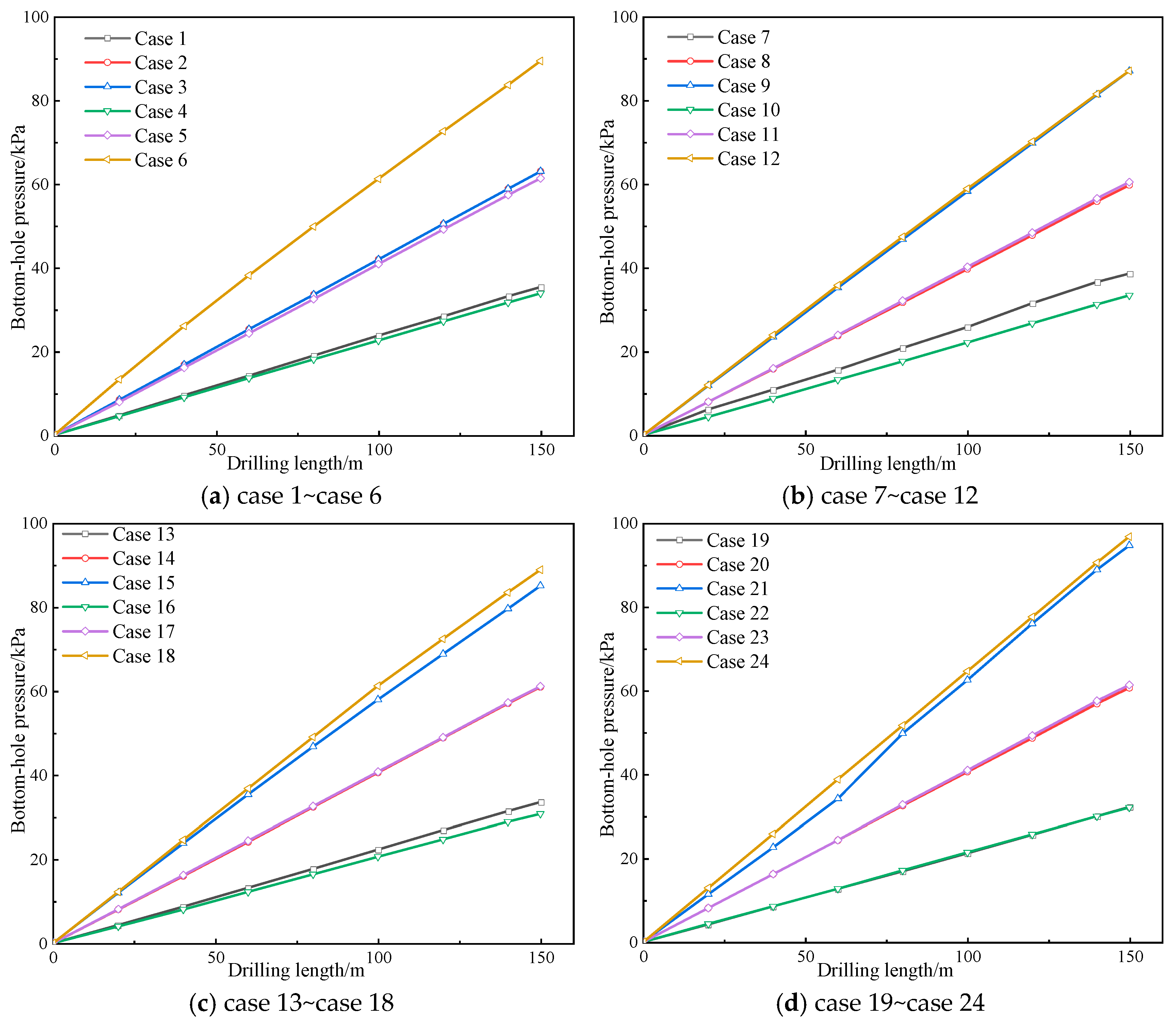

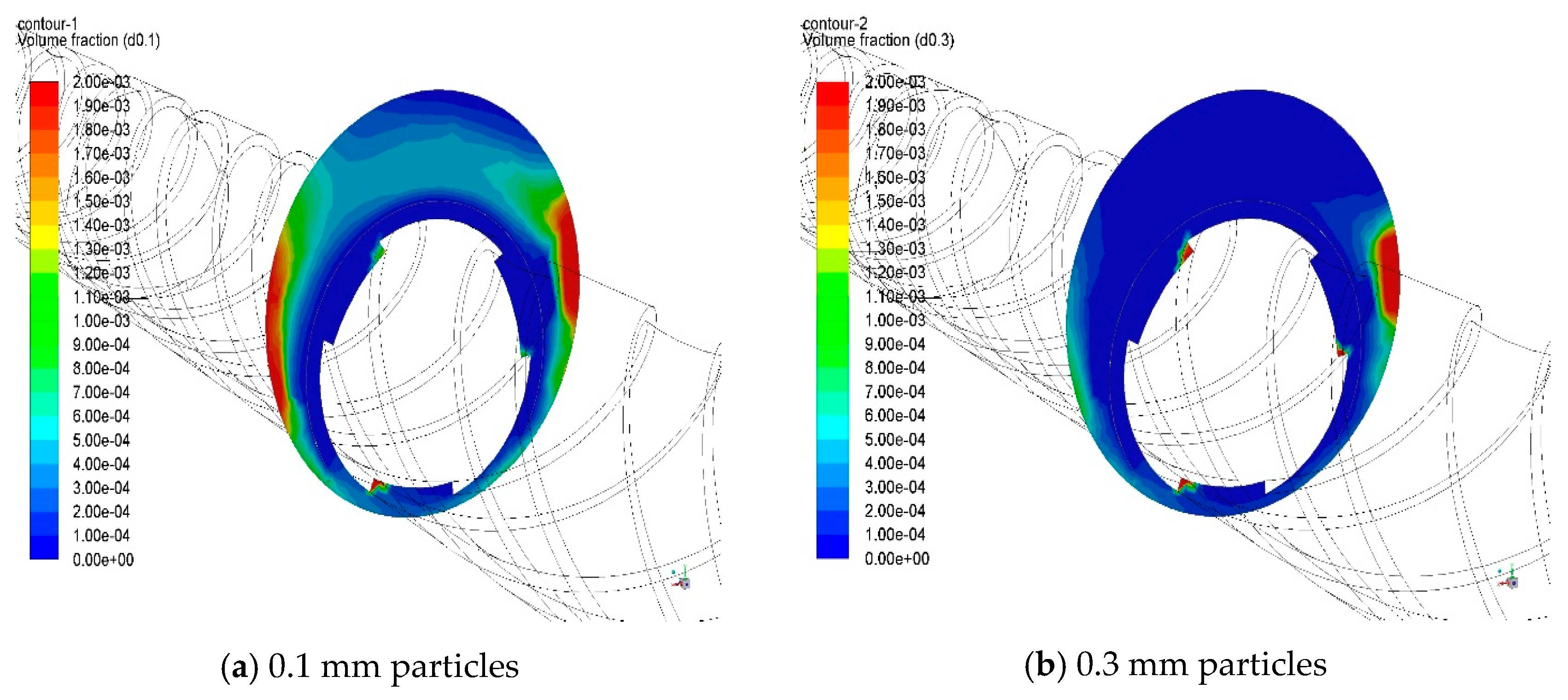


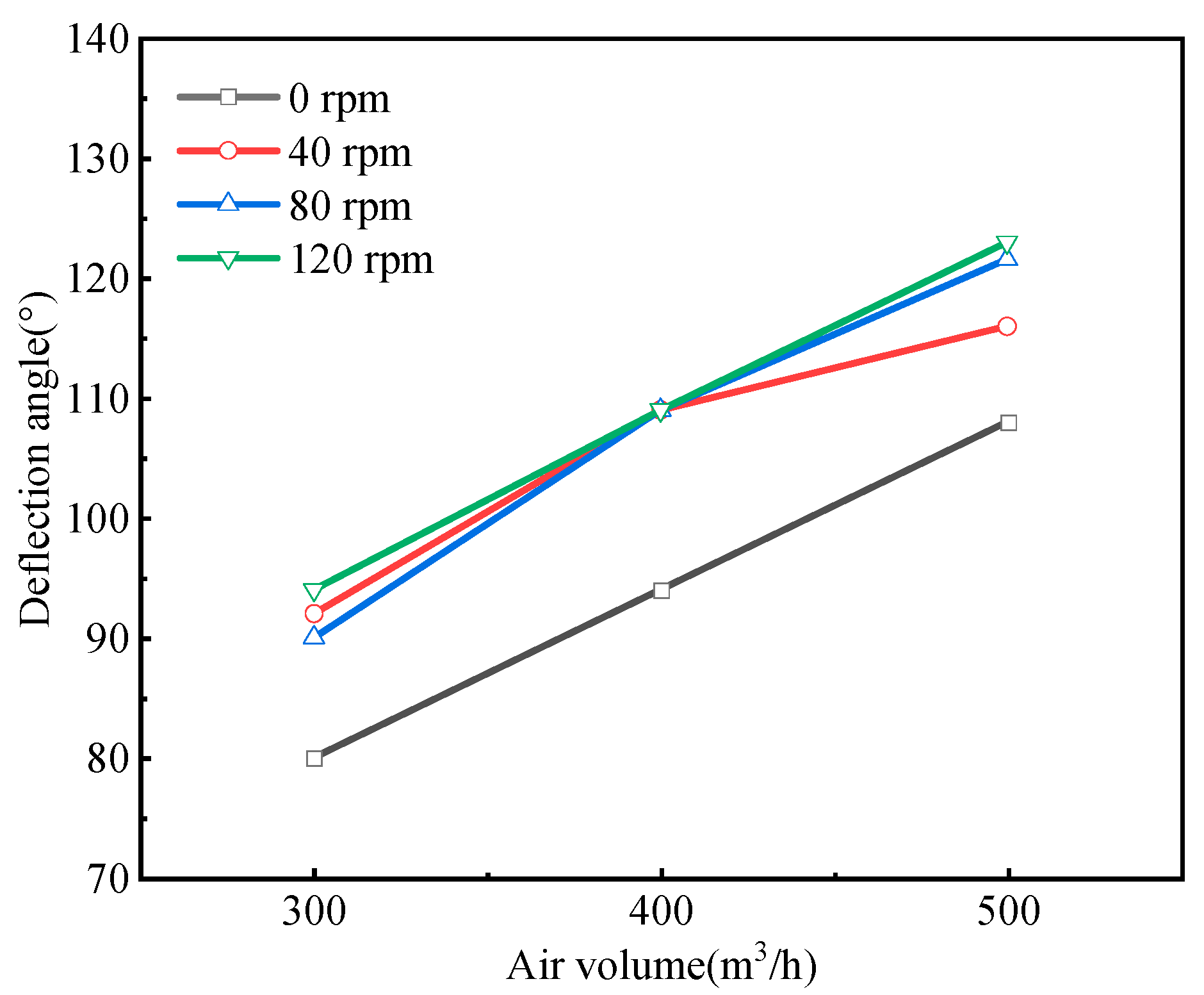
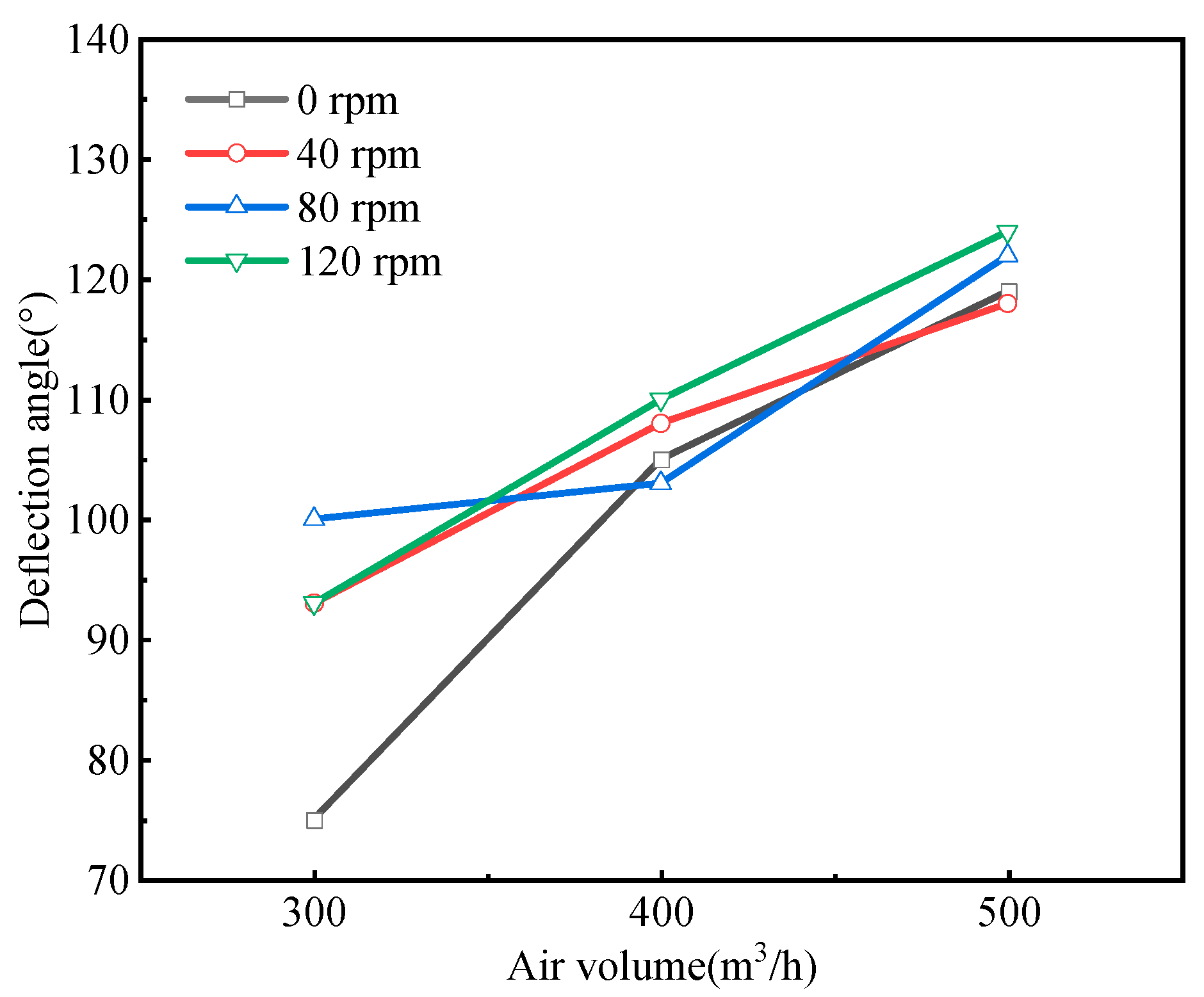
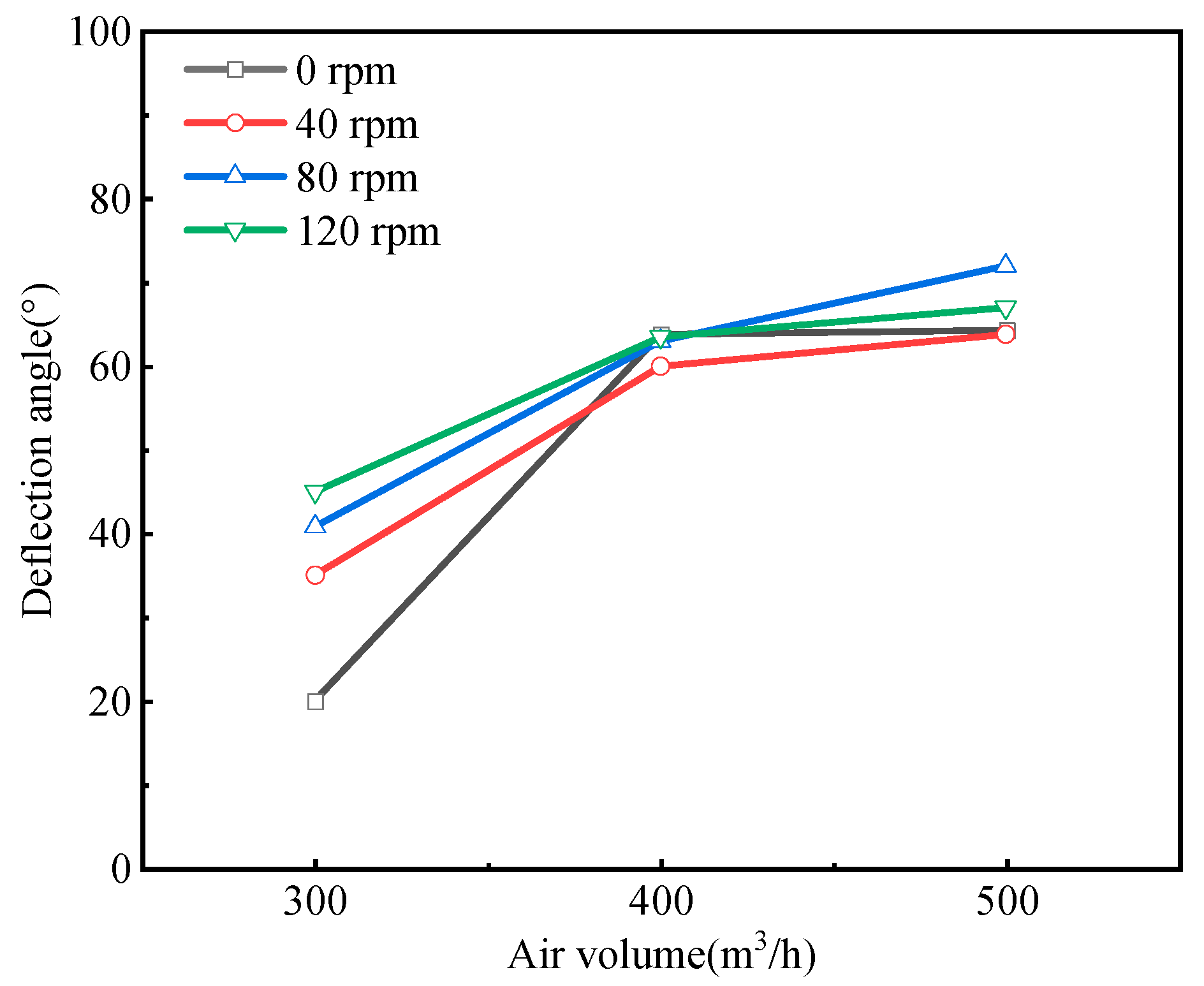
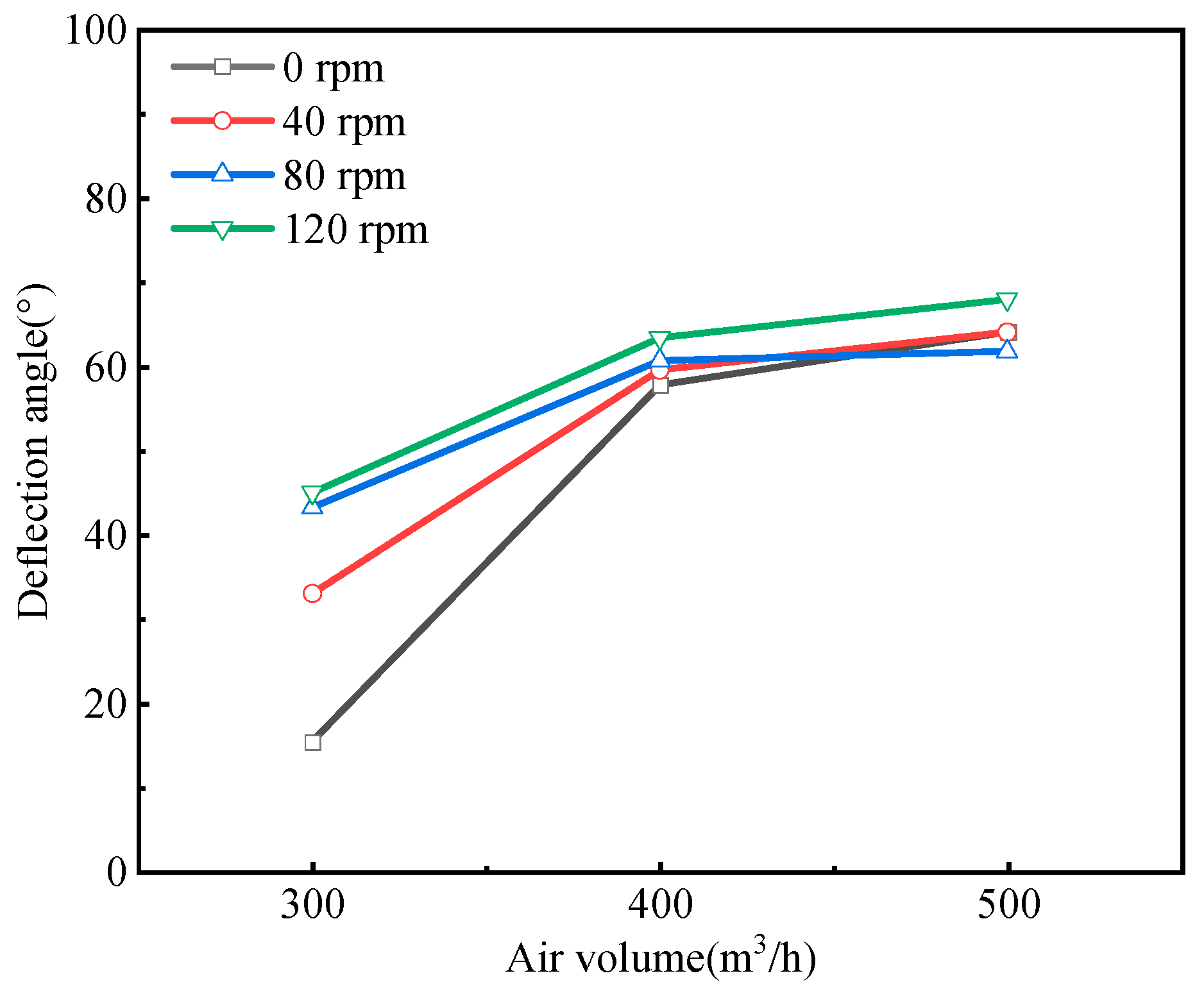





| Particle Size/mm | 0.1 | 0.3 | 0.75 | 1.69 |
|---|---|---|---|---|
| Percentage/% | 46 | 22 | 16 | 16 |
| Cases | A | B | C | Cases | A | B | C |
|---|---|---|---|---|---|---|---|
| Case 1 | 0 | 300 | 0.08 | Case 14 | 80 | 400 | 0.06 |
| Case 2 | 0 | 400 | 0.06 | Case 15 | 80 | 500 | 0.05 |
| Case 3 | 0 | 500 | 0.05 | Case 16 | 80 | 300 | 0.16 |
| Case 4 | 0 | 300 | 0.16 | Case 17 | 80 | 400 | 0.12 |
| Case 5 | 0 | 400 | 0.12 | Case 18 | 80 | 500 | 0.1 |
| Case 6 | 0 | 500 | 0.1 | Case 19 | 120 | 300 | 0.08 |
| Case 7 | 40 | 300 | 0.08 | Case 20 | 120 | 400 | 0.06 |
| Case 8 | 40 | 400 | 0.06 | Case 21 | 120 | 500 | 0.05 |
| Case 9 | 40 | 500 | 0.05 | Case 22 | 120 | 300 | 0.16 |
| Case 10 | 40 | 300 | 0.16 | Case 23 | 120 | 400 | 0.12 |
| Case 11 | 40 | 400 | 0.12 | Case 24 | 120 | 500 | 0.1 |
| Case 12 | 40 | 500 | 0.1 | Case 25 | 200 | 300 | 0.16 |
| Case 13 | 80 | 300 | 0.08 |
Disclaimer/Publisher’s Note: The statements, opinions and data contained in all publications are solely those of the individual author(s) and contributor(s) and not of MDPI and/or the editor(s). MDPI and/or the editor(s) disclaim responsibility for any injury to people or property resulting from any ideas, methods, instructions or products referred to in the content. |
© 2024 by the authors. Licensee MDPI, Basel, Switzerland. This article is an open access article distributed under the terms and conditions of the Creative Commons Attribution (CC BY) license (https://creativecommons.org/licenses/by/4.0/).
Share and Cite
Zhang, J.; Han, Z.; Chen, T.; Yao, N.; Yang, X.; Chen, C.; Cai, J. A Numerical Simulation of the Coal Dust Migration Law in Directional Air Drilling in a Broken Soft Coal Seam. Processes 2024, 12, 309. https://doi.org/10.3390/pr12020309
Zhang J, Han Z, Chen T, Yao N, Yang X, Chen C, Cai J. A Numerical Simulation of the Coal Dust Migration Law in Directional Air Drilling in a Broken Soft Coal Seam. Processes. 2024; 12(2):309. https://doi.org/10.3390/pr12020309
Chicago/Turabian StyleZhang, Jie, Zichen Han, Tianzhu Chen, Ningping Yao, Xianyu Yang, Chan Chen, and Jihua Cai. 2024. "A Numerical Simulation of the Coal Dust Migration Law in Directional Air Drilling in a Broken Soft Coal Seam" Processes 12, no. 2: 309. https://doi.org/10.3390/pr12020309
APA StyleZhang, J., Han, Z., Chen, T., Yao, N., Yang, X., Chen, C., & Cai, J. (2024). A Numerical Simulation of the Coal Dust Migration Law in Directional Air Drilling in a Broken Soft Coal Seam. Processes, 12(2), 309. https://doi.org/10.3390/pr12020309






